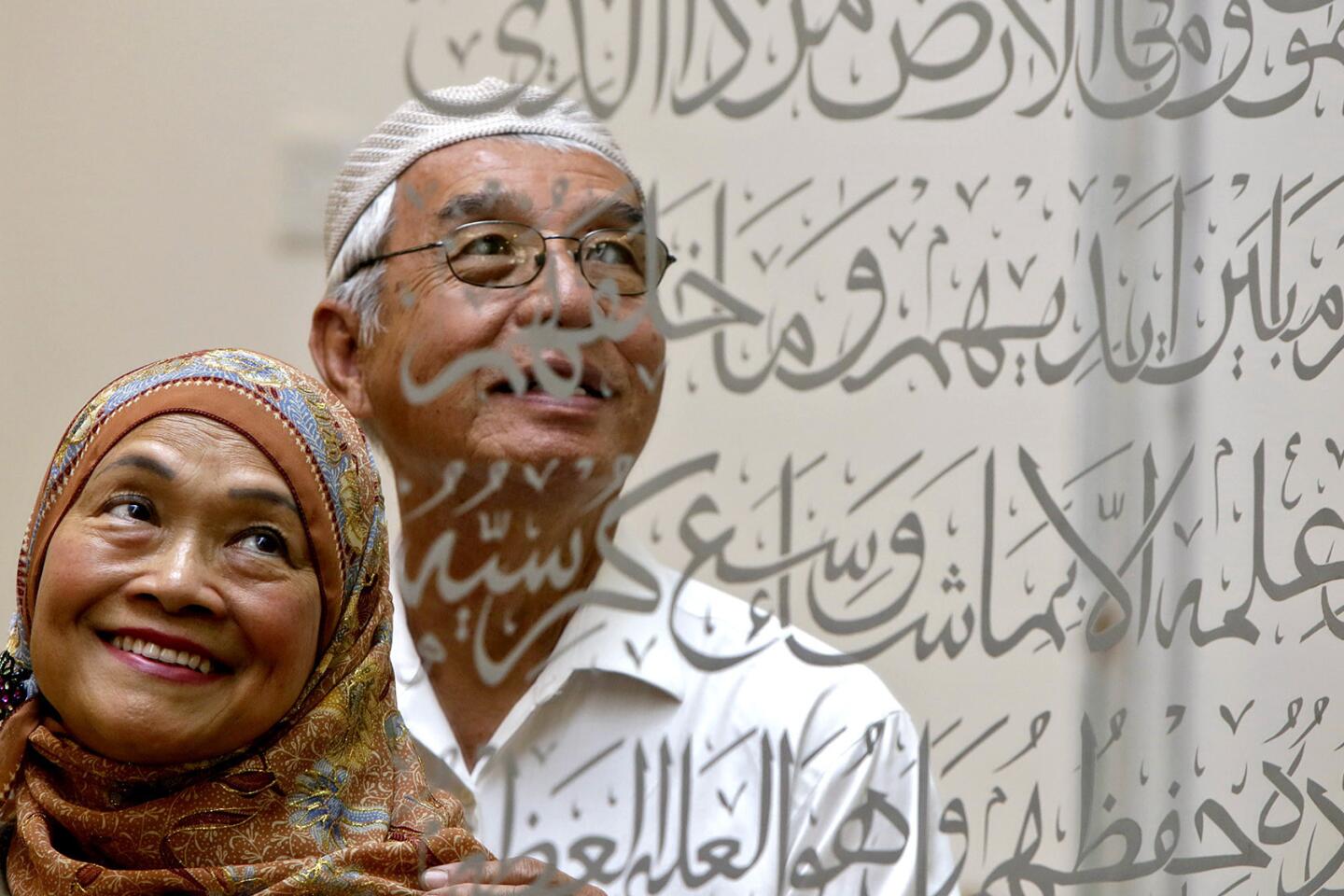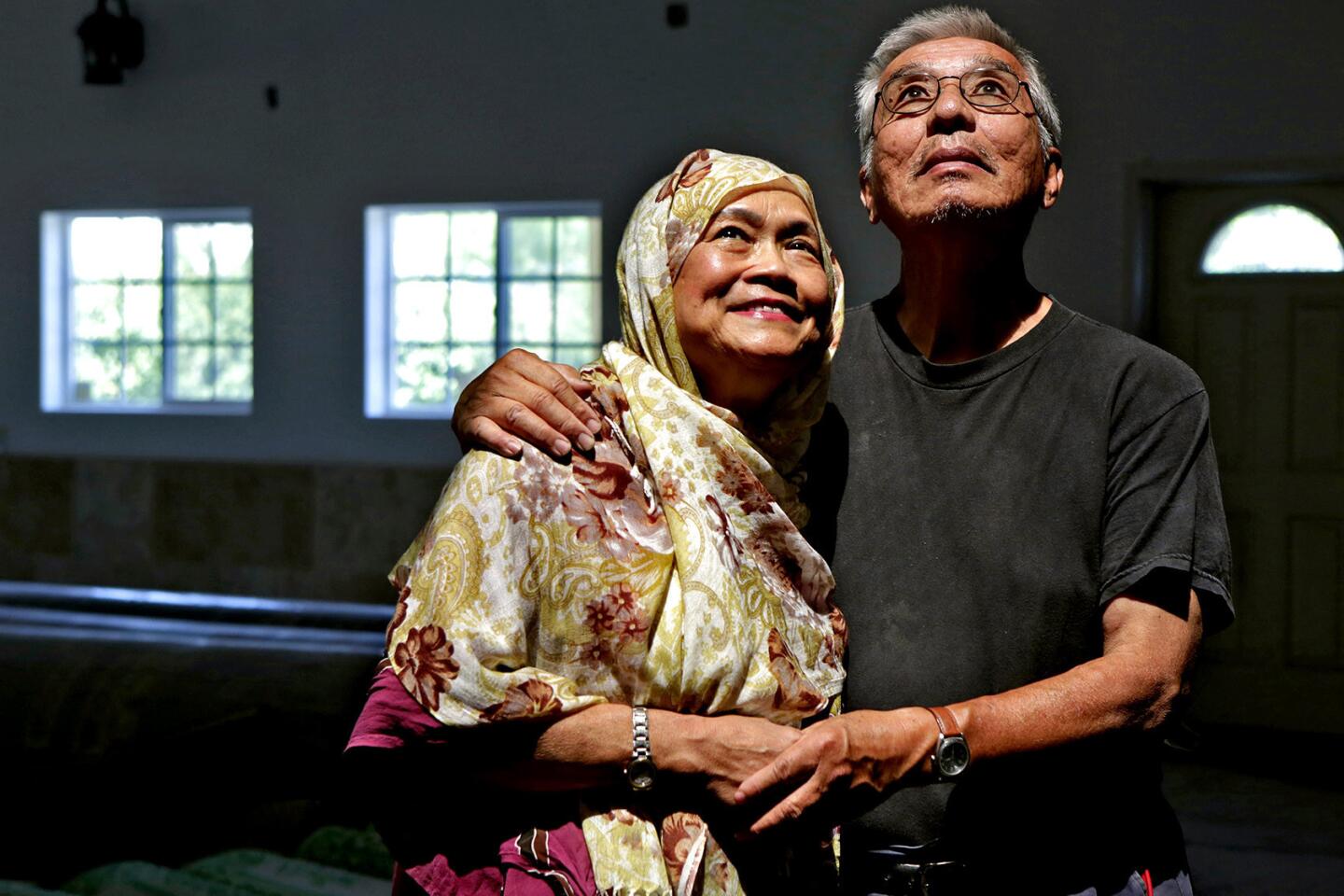Great Read: Thai Muslim mosque in Azusa is a work of faith
It is near midnight. The Ramadan prayers have just been said, the congregants have paid respect to Allah and headed home. Only the gray-haired imam and his wife remain at the little house of faith they have devoted their lives to.
They walk to their car, looking at the stars, reminiscing about a journey that began 50 years ago and a world away from a low-slung neighborhood up against the Los Angeles foothills.
“This has been quite something, all we have gone through leading us here,” says Rahmat Phyakul. With his wife, Sukatee, at his side, he points proudly to a tall green-and-white sign.
Masjid Al-Fatiha.
On the same sign, another message, this one in the flowing script of their native land. He pauses to translate: First Mosque Established by Thai Muslims in America.
“This place,” he says, “it’s our purpose in life.”
::
Their journey began in early-1960s Bangkok, where they grew up.
Rahmat and Sukatee worked together, and often would head to lunch with a group of others. Only she’d break away briefly and come back with food he didn’t recognize. “It’s halal,” she recalls telling him. “Muslim food. I’m Muslim.”
Like the vast majority of Thais, he’d been raised a Buddhist.
It didn’t take long for them to fall in love. Nor did it take long for them to discuss marriage. But she balked: She couldn’t marry someone who wasn’t Muslim.
By then he was falling for her religion too. He loved its values and simplicity, the firm belief in one, powerful God. In his family there were misgivings — among some who associated Islam with ignorance and aggression. But for him, Islam was the way of wisdom and peace.
In 1964, Rahmat became a Muslim and soon after married Sukatee. “The love of my life,” he says, speaking softly as he usually does. “I could do none of what I have done without her.”
Theirs isn’t just a spiritual tale, it’s a story of immigrants.
Soon after the wedding, they came to America, worked on their broken English, went to community college. He got a business degree from Cal State L.A. She began raising their two daughters in a modest Monrovia home.
The Phyakuls immersed their family in the region’s burgeoning Thai community, the largest in the world outside Thailand, with an estimated 50,000 currently in L.A. County. Within that group they became part of a tiny band of Thai Muslims — thought to be about 300 or so.
“The minority of the minority of the minority,” says Rahmat, now 73.
“We began thinking about what we wanted to pass on to our daughters,” says Sukatee, 71.
“There were certain things we wanted to maintain,” he says. “Our faith.”
They came up with an audacious plan: build a mosque of their own.
::
Southern California’s most established mosques traditionally have been built and maintained with support from the region’s Muslim business class, as well as from wealthy patrons in Africa, the Middle East and Pakistan.
The Phyakuls — lacking deep connections or the aggressive moxie to ask for help — forged ahead on little more than faith.
In the 1980s, they began cobbling together what savings they could for a down payment, partly by selling Thai food at local festivals.
Because Rahmat, a municipal finance manager, planned on leading the mosque, he had much to learn. Sukatee became his guide.
“I didn’t know how to pray as an imam does,” he says. They would practice together, her standing behind him, chanting lengthy verses she’d memorized as a child. “My wife taught me to pray,” he says. “It took a long time, but finally I got it. Finally, I was ready.”
And finally, in the mid-1990s, they found a location for their mosque: an abandoned medical building on a bustling boulevard in Azusa that had been used as a hideout by drug users. Its walls had dry rot; its flat roof hadn’t been repaired in years.
Perfect, they thought, doling out the $5,000 they’d saved, with the help of a small group of supporters. All the while they prayed they’d attract enough fellow believers to pay the mortgage and maybe, one day, renovate a building that was nearly uninhabitable.
“We leaned on patience,” says Rahmat.
Those first few Friday prayer meetings, just a few believers showed up, prostrating among buckets placed strategically to catch streams of water pouring from the leaky roof.
::
Is Al-Fatiha, in fact, the first mosque in America built by Muslim Thais? Nobody keeps the kinds of records that would pin down such a claim. But Thai community leaders in L.A. don’t doubt it, and Islamic scholars say it’s almost certainly true.
“All my travels, I’ve certainly never heard of another one,” said Jihad Turk, religious advisor at the Islamic Center of Southern California, one of the nation’s most prominent mosques. “They stand out.”
In the renovated prayer hall, children play and giggle on the plush green carpet, then happily follow the imam’s rhythmic chants. The mosque has a family-oriented, understated feel.
“They’ve created a place of worship that’s focused and warm,” says one longtime attendee, Dr. Shafeeq Shamsid-Deen. “Giving ... reverent. It’s a beautiful thing to see.”
Congregants are not just from Southeast Asia but all over the globe, yet there’s little talk of international politics — even now, with conflict in Gaza.
Following Islamic tradition, during prayer the men sit in front, but there’s no wall or curtain separating the sexes. When prayers finish, men and women converse with an ease that can be bracing for those from more conservative Islamic traditions.
“We are relaxed here,” says Rahmat, whose daughters, Subaida and Aranyanee, help administer events and keep the books. “Over the years, outsiders have come and told me: ‘Put the women behind a curtain; they can watch from a TV.’ I say to them: ‘The whole world looks at Islam as suppressing women. How are we going to change that? No curtains, no walls here, ever.’”
Nothing about the journey has been easy.
The Phyakuls dipped well into their retirement fund, the congregation saved what it could, and finally there was enough money to begin an earnest remodel. Today, despite a new exterior — a new roof, curving arches, travertine trim and gleaming walls — significant parts of the mosque remain under construction.
A final plan calls for Thai wood carvings and a narrow minaret topped with Thai teak, among other additions, but finishing remains a dream: $100,000 is needed, money the mosque and its clutch of mostly middle-class supporters don’t have.
Al-Fatiha has been burglarized, vandalized and shot at with a BB gun. Someone broke in and urinated on the prayer rugs. Hate crimes, figures Rahmat, who since retiring in 2007 has spent most of his time working on the mosque: painting, putting up drywall, planting lemon grass and fruit trees, overseeing contractors, whatever has been needed to keep the place going.
Once he was outside when he heard a car speed by and someone shout, “Osama Bin Laden! Terrorist. Go home!”
“It doesn’t bother me,” he says, tentatively. He notes that the threats and break-ins have decreased in recent years, but he nonetheless remains on constant guard.
There are, of course, other worries. Paying the mortgage is one. Attracting enough believers, another.
The mosque bustled this weekend, the end of Ramadan, to be punctuated by Monday’s food-filled celebration, known as Eid al-Fitr. But on many of the evenings during the holy month, only about 25 believers attended the final prayers.
“Sometimes I wonder if it is all worth it. Will we finish our building and have enough regulars?” Rahmat says, noting how bone-wearying the job has become as he has grown older. “At night, I walk out of the hall and look up at the stars and I wonder. And then I look at the sign — first Thai mosque — and I know that Allah has a plan. I feel better. I feel we are blessed.”
Twitter: @kurtstreeter
More to Read
Sign up for Essential California
The most important California stories and recommendations in your inbox every morning.
You may occasionally receive promotional content from the Los Angeles Times.



















